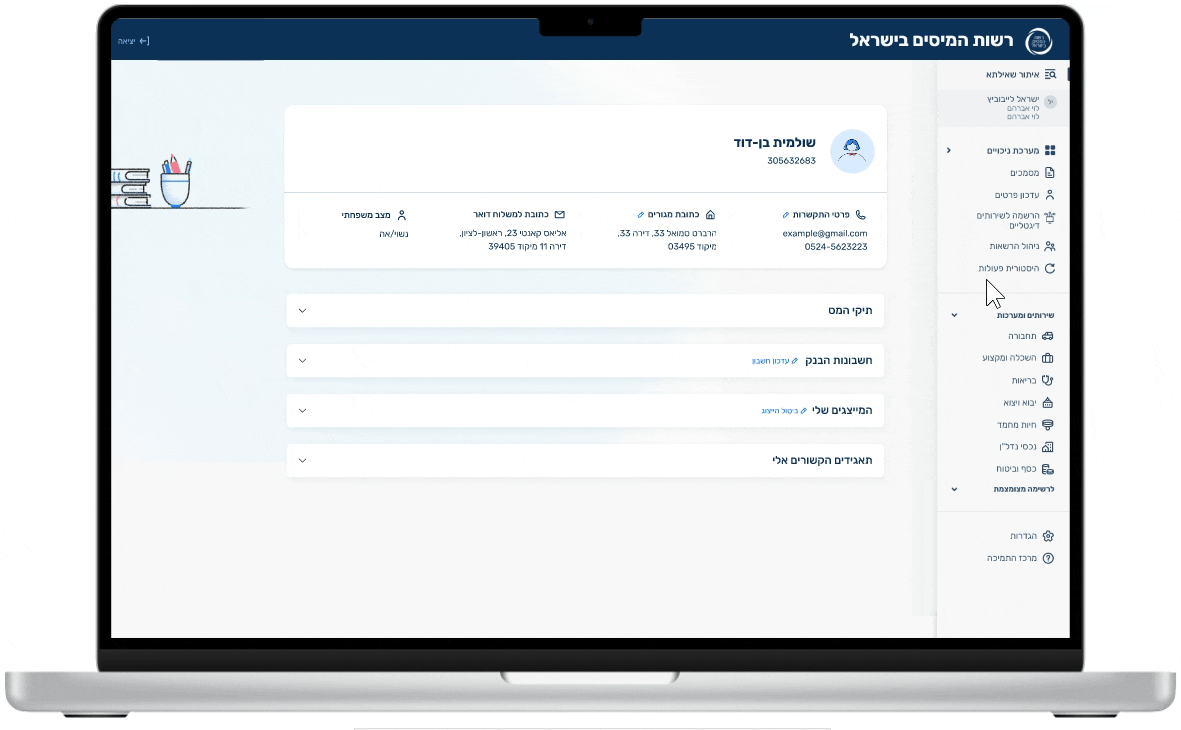UX Designer & Researcher
Israel Tax Authority

Work Overview
As part of my work at the Tax Authority as a user experience designer, I was part of a user experience team where I performed a wide variety of studies, characterized infrastructure components that would fit a wide variety of systems, and took part in the characterization of computer and phone systems.
My Details Section
Currently, users' personal details are dispersed across our website. I've developed a consolidated personal hub, streamlining user information and related tasks. Deciding on the essential elements and functions demanded close partnership with stakeholders, rooted in transparent dialogue and keen insights into user preferences. I have incorporated several user experience (UX) principles into the design of this personal hub:
-
Information Architecture and Hierarchical Organization: Prioritize a structured hierarchy of content and actions, ensuring users can swiftly locate what they are looking for.
-
User-Centered Design: Present all essential personal information and associated actions on a single page, keeping the user’s needs at the forefront.
-
Task Flow and User Journeys: Ensure a seamless process for users. Whether it's updating a bank account or canceling a representation, our design aids users in achieving their objectives without superfluous steps.
-
Model Dialogs (Pop-ups): Strategic use of pop-ups for specific actions maintains context. A model dialog captures user attention on the immediate task without diverting them from their main page.
-
Consistency and Visual Design: The platform adheres to a defined design system, incorporating consistent typography, color schemes, illustrations, and more.

Form Digitization
I converted a manual form into a digital one and incorporated multiple UX design elements to enhance the user experience. The principles I used are:
-
User-Friendly Approach: By simplifying and grouping related fields together, I made the form more intuitive. A hierarchical arrangement was used to present related sections within a step-by-step process.
-
Radio Buttons and Toggles: I chose these interactive elements to optimize the user experience.
-
Collapsible Sections: Introducing collapsible sections helps in reducing cognitive load. Instead of overwhelming users with information, they can access sections individually.
-
Summary and Confirmation Page: Before submission, users get an overview of their inputs. This allows them to review and correct mistakes, ensuring accuracy and boosting their confidence.
-
Tone Of Voice: I used clear and user-friendly language throughout the form to ensure that instructions and questions were easy to understand.

User Research
7 self-employed individuals were interviewed, each being partially/fully or not at all represented by an accountant. Based on the interviews, we found that both need and emotion were important parameters.
Need-Based Factors:
Availability of Information:
-
Real-time display of account status and actions.
-
Important notifications (e.g., outstanding debts) will delivered via email.
-
A comprehensive summary of all actions undertaken.
Flexibility:
-
An expressed desire by some self-employed to split payments across multiple credit cards, offering clarity on what was paid, when, and how.
Transparency:
-
access to details, like the number of credit points, eligibility for various grants, and more.
Consolidation of Operations:
-
The ability to make multiple payments (e.g., VAT and advances) simultaneously, but view them as distinct transactions.
Certainty:
-
The opportunity to oversee the accountant's work and validate their actions.
Emotion-Based Factors:
Helplessness:
-
A feeling that accountants possess knowledge and techniques that they lack.
-
A sense of obligation to let professionals handle tasks like annual reporting because of their specialized expertise.
Frustration:
-
Encountering obligations or jargon that they don't understand, leads to confusion about necessary actions and future steps.
Mystery:
-
Each financial obligation feels unpredictable, with payments to entities like the income tax department and VAT often coming as unexpected surprises.
Fear:
-
Overwhelming anxiety about making mistakes in crucial submissions such as annual reports or capital statements. This fear, stemming from potentially severe consequences, often drives them to seek professional representation.

Customs payment
Before researching customs payments with behavioral economics experts, I scoured social networks, government, and personal websites. My aim was to find comprehensive details about customs duties and restrictions, but no single source had all the answers.
Additionally, I undertook an anthropological study at Ben-Gurion Airport. I positioned myself at the green lane and observed customs operations in collaboration with one of the project managers.
Project Purpose:
Implement nudges to alter the behavior of individuals passing through the base by considering:
-
Airport customs policy features.
-
The target population whose behavior we aim to change.
-
Factors driving the current behavior of this group.
The Nudges Need To Be
Simple to execute
Cost-effective
Doesn't bother
Make change
Awareness of Customs Policy
From a survey of 150 passengers:
-
79% are unaware of what items need to be declared to customs upon entering the country.
-
64% haven't read any online information regarding customs.
-
Among those who did read online information, 77% believe it is not easily accessible or sufficient.
Customs Policy Flow

A Sample of Nudge
